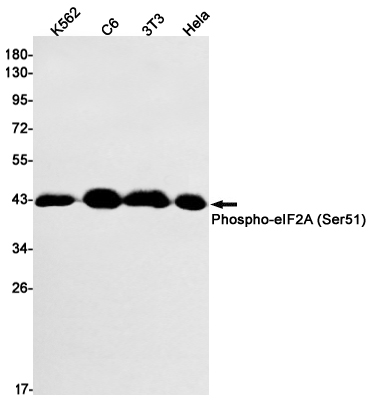
| WB | 咨询技术 | Human,Mouse,Rat |
| IF | 咨询技术 | Human,Mouse,Rat |
| IHC | 咨询技术 | Human,Mouse,Rat |
| ICC | 技术咨询 | Human,Mouse,Rat |
| FCM | 咨询技术 | Human,Mouse,Rat |
| Elisa | 咨询技术 | Human,Mouse,Rat |
| Aliases | EIF2S1; EIF2A; Eukaryotic translation initiation factor 2 subunit 1; Eukaryotic translation initiation factor 2 subunit alpha; eIF-2-alpha; eIF-2A; eIF-2alpha |
| Entrez GeneID | 1965 |
| WB Predicted band size | Calculated MW: 36 kDa; Observed MW: 36 kDa |
| Host/Isotype | Rabbit IgG |
| Antibody Type | Primary antibody |
| Storage | Store at 4°C short term. Aliquot and store at -20°C long term. Avoid freeze/thaw cycles. |
| Species Reactivity | Human,Mouse,Rat |
| Immunogen | A synthetic phosphopeptide corresponding to residues surrounding Ser51 of human EIF2S1 |
| Formulation | Purified antibody in TBS with 0.05% sodium azide,0.05%BSA and 50% glycerol. |
+ +
以下是3篇与Phospho-eIF2α(Ser51)抗体相关的参考文献(注:文献中通常使用“eIF2α”而非“eIF2A”,此处保留原名称但按标准术语调整):
---
1. **文献名称**:*Protein translation and folding are coupled by an endoplasmic reticulum-resident kinase*
**作者**:Harding, H.P., et al.
**摘要**:该研究首次报道内质网应激通过PERK激酶磷酸化eIF2α(Ser51),利用特异性抗体检测磷酸化修饰,证明其抑制全局蛋白翻译并激活应激信号通路。
2. **文献名称**:*The integrated stress response*
**作者**:Ron, D. & Harding, H.P.
**摘要**:综述eIF2α(Ser51)磷酸化在整合应激反应(ISR)中的核心作用,强调使用Phospho-eIF2α抗体作为关键实验工具,检测多种细胞应激(如病毒感染、营养缺乏)下的通路激活。
3. **文献名称**:*Regulation of translation initiation in health and disease*
**作者**:Wek, R.C., et al.
**摘要**:探讨eIF2α磷酸化对翻译起始的调控机制,通过该抗体的Western blot分析,揭示其在神经退行性疾病模型(如阿尔茨海默病)中的异常激活。
---
**备注**:若需技术性抗体验证文献,可参考抗体生产商(如Cell Signaling Technology, CST #9721)提供的应用指南及引用文献。
The Phospho-eIF2α (Ser51) antibody detects the phosphorylated form of eukaryotic translation initiation factor 2 alpha (eIF2α) at serine 51. a key regulatory site in cellular stress responses. eIF2α is a subunit of the eIF2 complex, essential for initiating protein synthesis by delivering methionyl-tRNA to ribosomes. Under stress conditions (e.g., ER stress, nutrient deprivation, viral infection), kinases such as PERK, PKR, HRI, or GCN2 are activated, phosphorylating eIF2α at Ser51. This phosphorylation converts eIF2 from a substrate to a competitive inhibitor of its guanine nucleotide exchange factor, eIF2B, thereby attenuating global protein synthesis while selectively promoting translation of stress-responsive mRNAs (e.g., ATF4), which drive adaptive gene expression.
The Phospho-eIF2α (Ser51) antibody is widely used to study cellular stress pathways, including the unfolded protein response (UPR), oxidative stress, and amino acid deprivation. It serves as a biomarker for detecting activation of integrated stress response (ISR) signaling in diseases such as neurodegeneration, cancer, and metabolic disorders. Researchers employ this antibody in techniques like Western blotting, immunofluorescence, and immunohistochemistry to assess eIF2α phosphorylation status in vitro and in vivo. Its specificity for the phosphorylated Ser51 residue ensures accurate monitoring of stress-induced signaling, aiding mechanistic insights into translational control and therapeutic targeting of stress-related pathologies.
×